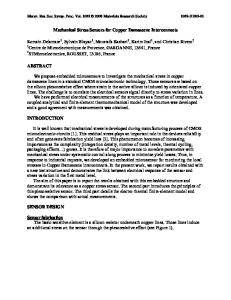High-temperature oxidation of metallic alloys for SOFC interconnects: stress and morphological developments during oxide
- PDF / 179,857 Bytes
- 7 Pages / 612 x 792 pts (letter) Page_size
- 51 Downloads / 300 Views
1170-R03-05
High-temperature oxidation of metallic alloys for SOFC interconnects: stress and morphological developments during oxide scale growth. Audric Saillard1, 2, Mohammed Cherkaoui1, 2, Laurent Capolungo3, Esteban P. Busso4 Woodruff School of Mechanical Engineering, Georgia Institute of Technology, Atlanta, GA, USA. 2 UMI 2958 Georgia Tech - CNRS, Metz, France. 3 Materials Science and Technology Division, Los Alamos National Laboratory, Los Alamos, NM, USA. 4 Centre des Matériaux, Mines ParisTech, Evry, France. 1
ABSTRACT This work investigates the critical stress and morphological evolutions which occur during the high-temperature oxidation of metallic alloys for SOFC interconnects. Two mechanisms of stress generation are considered related to (1) the local volume change associated with the direct oxidation of the metal and to (2) a secondary oxidation process within grain boundaries. A specific formulation is developed to include the influence of the stress state at the metal-oxide interface on the local oxidation kinetics. The oxidation of a chromia-forming SOFC interconnect metallic alloy is simulated and stress and morphological evolutions are investigated.
INTRODUCTION Stress development and resulting phenomena, such as deformation and crack nucleation, often limits the lifetime of material systems undergoing high temperature oxidation. In Solid Oxide Fuel Cell (SOFC) interconnects, it can lead to the oxide scale spallation and failure after few tens or hundreds of hours, degrading the device and jeopardizing its reliability. Most metallic alloys for SOFC interconnects are designed to form a Chromia layer due to its interesting electrical conductivity. In addition, all commercial alloys now include reactive elements (as yttrium, cerium, and lanthanum) or their oxides [1]. The additions in minor proportions of these elements have demonstrated dramatic effects on oxide scale development, particularly in terms of growth kinetics, morphology and microstructure, as well as on stress generation. These effects can lead to significant improvement in the component lifetime. However in this situation, the chromia scales have been proved to develop by significant if not dominant inward oxidation of the metallic substrate, unlike regular Chromia scales which essentially form outward at the free surface [2]. Consequently, the oxidation at the inner interface becomes more critical. The oxidation of the metal phase in a confined space is likely to generate very high stresses. Furthermore, the geometry of this interface is of primary concern since it might lead to high stress concentration upon cooling due to the thermal mismatch between the metallic phase and the oxide. A framework and an associated simulation tool have been developed in order to investigate stress and morphological developments during the oxide scale growth. The key points of the framework are described, and simulation results for the growth of a chromia scale at
800°C in a case representative of the oxidation of a metallic alloy doped with react
Data Loading...











